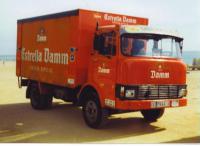DAC

Since 1971, Brasov Automobile Plant "Intreprinderea de Autocamioane Brashov", abbreviated as IAB, switched to the production of Roman trucks range and diesel engines under the license of German company MAN. By that time, the old Steagul Roshu Bucegi range with gasoline-powered V8 still remained in production. With the replacement of these engines in 1973 by the new in-line 6-cylinder diesels MAN (5489 cm3, 135 hp), the trucks were branded as DAC. At the same time they received an updated frame and suspension, some changes in transmission, allowing to raise the maximum capacity from 5 to 6 tons.
Abbreviation DAC was formed from the name Diesel Automobil Camion, which can be translated from Romanian as "Diesel truck." However, the brand DAC reminded about the history of country, once inhabited by Dacian tribes. Under this brand the company produced different trucks and special vehicles, buses and trolley buses, as well as advanced engines, created by their own.
In the early 80s, the company developed their own diesel engines rated at 240, 280 and 320 hp, went beyond the scope of the license agreement and marked with an additional letter "R" - "Romanian". They were used for DAC trucks (from the "16.240" to "32,280" models). In 1984, after the license with MAN was ended, the Roman range was renamed to DAC. In 1990, by the government's decision Brasov plant was transformed into joint-stock company "Roman S.A.". The plant had lost large markets and started to equip the old chassis with imported units, primarily diesel engines that meet new environmental requirements. DAC trucks were continued to produce for several years after 1990, and the company even made a special version for a local fuel company with an updated design. At this time, the company used both DAC and Roman brands according to buyer's request. But the trucks were absolutely identical. In 2004, S.C. ROMAN S.A. Brasov was privatized. New shareholders decided to use only Roman brand for all trucks.


